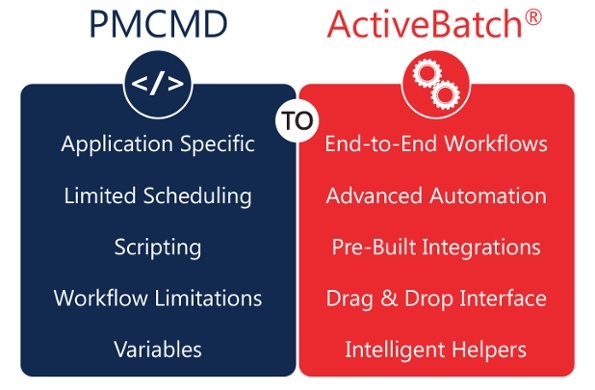Enhance your IT workflows with PowerCenter PMCMD and IT automation
Unlock the potential of PMCMD and ActiveBatch to boost the efficiency and flexibility of your Informatica PowerCenter data integration workflows.

Informatica PowerCenter is a widely used data integration tool crucial for building enterprise data warehouses and managing data workflows. PowerCenter IT automation takes this a step further, streamlining processes and reducing manual tasks to improve efficiency. PMCMD, a command-line program for PowerCenter, automates workflow tasks, adding flexibility and precision to IT operations.
Automating PowerCenter workflows with PMCMD involves scripting commands to start, stop and manage workflows. This process significantly reduces the time and effort required to handle repetitive tasks, allowing IT teams to focus on more strategic initiatives.
Leveraging tools like PowerCenter and PMCMD for automation helps businesses create seamless workflows that enhance productivity and data management. ActiveBatch provides a robust solution for automating PowerCenter workflows, offering capabilities beyond the built-in PowerCenter scheduler and PMCMD.
What is PowerCenter used for?
PowerCenter is primarily used for data integration — a robust platform for extracting, transforming and loading (ETL) data from various sources into a centralized data warehouse. This process ensures data is accurate and consistent, which is crucial for making informed business decisions. PowerCenter’s extensive functionality supports complex data integration tasks, making it a go-to solution for many enterprises.
Informatica PowerCenter helps businesses manage vast amounts of data by automating ETL processes. It reduces the need for manual intervention, allowing IT teams to focus on more strategic activities. Using PowerCenter, organizations can streamline their data workflows, improving overall efficiency and reliability.
Key functions and applications of PowerCenter
One of PowerCenter’s key functions is its ability to handle large-scale data integration projects. It supports various data formats and sources, including databases, cloud services and flat files. This versatility makes it an essential tool for organizations to consolidate data from disparate systems.
PowerCenter is also highly valued for its ETL capabilities, which save time and ensure data integrity and accuracy. It can efficiently extract data from multiple sources, transform it according to business rules and load it into a target data warehouse. PowerCenter provides comprehensive tools for monitoring and managing ETL workflows, which helps maintain the quality and reliability of data.
Automating these tasks with tools like PMCMD enhances PowerCenter’s efficiency. PMCMD allows users to script workflow commands in command line mode on Windows, Linux or Unix operating systems. Such flexibility is crucial for integrating PowerCenter into diverse IT environments and optimizing data workflows.
PMCMD automation: Boundaries identified
Because PMCMD is a command-line utility, it’s important to be familiar with its syntax and commands to utilize it effectively. For instance, the pmcmd startworkflow command initiates workflows, while pmcmd stopworkflow halts them. PMCMD also supports scripting, which means you can automate commands within shell scripts, making it easier to handle repetitive tasks.
Use cases and examples
PMCMD can be used for a variety of tasks within PowerCenter. For example, teams can automate the execution of a workflow at a specific time each day by scheduling the pmcmd startworkflow command using a job scheduler like ActiveBatch. PMCMD allows you to pass parameters to workflow to simplify dynamic data processing tasks.
Consider a scenario where you need to update a data warehouse nightly. Using PMCMD commands, you can script a series of commands to extract data from various sources, transform it and load it into the target database. You can also configure PMCMD to send notifications upon the completion or failure of these tasks, ensuring that you stay informed about the status of your workflows.
A comprehensive automation solution that includes pre-built templates, integrations and advanced scheduling features complements PMCMD to make it easy to configure and manage PowerCenter workflows and reduce the need for custom scripting and improving overall efficiency.
The downside to custom scripts
While custom scripting with PMCMD offers flexibility, it also brings several challenges. One significant issue is the complexity involved in writing and maintaining these scripts. Creating and managing custom scripts requires a deep understanding of the PMCMD command reference, including syntax and available command tasks. As scripts become more intricate and difficult to troubleshoot, there’s a greater risk of inefficiency.
Another challenge is the potential for errors. Custom scripts are prone to mistakes, which can cause workflows to fail or produce incorrect results. Errors in scripting can be time-consuming to diagnose and fix, leading to downtime and disrupted business processes. Maintaining custom scripts over time can become burdensome, particularly as workflows and business requirements evolve.
Maintaining efficiency with minimal errors
Custom scripts also require regular updates and maintenance to ensure they continue to function correctly as system configurations and data integration need change. Ongoing maintenance can be resource-intensive, diverting IT staff from more strategic tasks. Furthermore, each change introduces the risk of new errors and makes the entire process more fragile.
Using PMCMD for automation also means relying heavily on slow, manual interventions to manage parameters and environment-specific configurations, such as domain name, service name, folder name and file name.
Simplifying end-to-end workflow creation
IT automation tools like PowerCenter provide significant benefits by streamlining workflows and enhancing productivity so IT teams can handle complex data integration tasks more efficiently. Automating these processes reduces the need for manual intervention, saving time and minimizing the potential for human error.
Benefits of IT automation tools
One of the primary benefits of using IT automation tools is the ability to create end-to-end workflows that integrate various systems and applications. For example, PowerCenter can connect with multiple data sources, including databases, cloud services like Informatica Cloud and on-premises systems. Data flows smoothly across the organization, supporting better decision-making and operational efficiency.
Automation tools also enhance productivity by enabling IT teams to focus on high-value tasks instead of repetitive manual processes. Leveraging features like APIs and pre-built integrations, businesses can quickly adapt to changing requirements and scale their operations. Some automation tools also support advanced orchestration and workload automation to further streamline IT operations.
PowerCenter simplifies the creation and management of complex workflows, helping businesses achieve their automation goals more effectively. Integrating various data sources and applications ensures accurate workflow execution.
Enhance IT automation with ActiveBatch and PowerCenter

ActiveBatch offers a unique and powerful approach to automating PowerCenter IT workflows, with capabilities beyond built-in schedulers and PMCMD. By integrating seamlessly with PowerCenter, ActiveBatch simplifies the automation process and enhances overall efficiency.
Integration with ActiveBatch
ActiveBatch integrates directly with Informatica PowerCenter and Cloud, providing pre-built, pre-tested, templated integrations that can be easily dragged and dropped to automate workflows. These templates eliminate the need for complex custom scripting, making it easier for users to build and manage workflows. The ActiveBatch extensions for Informatica PowerCenter and Cloud are available in the Informatica Marketplace and have earned the Informatica Seal of Approval.
One of ActiveBatch’s standout features is its ability to create end-to-end workflows that integrate with various systems and applications. This includes popular databases like SQL Server and Oracle and cloud services like Salesforce and SAP. By leveraging ActiveBatch’s capabilities, you can ensure your data integration processes are efficient and reliable.
Key features and benefits
ActiveBatch offers several features that enhance PowerCenter and IT automation, including robust scheduling capabilities, event triggers and file constraints. Users can set constraints to wait for files to be closed before starting dependent workflows. ActiveBatch also supports dynamic parameter setting at runtime for greater flexibility in managing workflows.
Another key benefit is the platform’s ability to monitor and manage service-level agreements (SLAs). To ensure you complete workflows on time and meet business requirements and expectations, ActiveBatch also provides comprehensive alerting and monitoring features to keep users informed about the status of their workflows.
With its advanced scheduling engine, ActiveBatch simplifies the management of complex workflows, reducing the time and effort required to automate processes. This powerful tool supports many applications and systems, making it an essential component of any IT automation strategy.
ActiveBatch’s powerful workload automation engine simplifies PowerCenter scheduling and offers capabilities beyond the native Informatica PowerCenter scheduler. It allows users to build workflows into end-to-end processes without custom scripting.
PowerCenter IT and PMCMD Automation offer powerful solutions for managing and streamlining IT workflows via data integration, ETL processes and automation. Using PMCMD for command-line automation further enhances workflow flexibility and precision.
If you want enhanced automation and easier management of complex workflows, ActiveBatch offers pre-built templates and advanced scheduling features, reducing the need for custom scripting. To see how your organization can benefit, sign up for an ActiveBatch demo.
Informatica PowerCenter FAQs
Informatica is an automation tool particularly known for its data integration capabilities. Informatica PowerCenter automates ETL processes, allowing businesses to manage and integrate data from various sources efficiently. It supports the automation of Informatica workflows, enhancing efficiency and reducing manual intervention. Informatica integrates with systems like IBM, Microsoft, SharePoint and SAP, supporting cloud automation, RPA and secure domain management. It also offers features like schedule workflow and comprehensive tutorials.
Seamlessly integrate Informatica Cloud and PowerCenter processes with other technologies, applications and environments with ActiveBatch.
PowerCenter is primarily used for data integration, enabling businesses to efficiently extract, transform and load (ETL) data from various sources into a centralized data warehouse. This tool supports a range of operations, including starting and stopping tasks, managing workflows and integrating various applications. PowerCenter’s capabilities include handling Java apps, configuring LDAP settings, managing parameter files and setting permissions. It uses plugins to extend functionality and supports complex integration services. Recognized by Gartner as a top solution, PowerCenter simplifies data workflows and improves overall efficiency with features like gettaskdetails, abortworkflow, starttask and stoptask. It provides robust error handling through return codes and ensures seamless data flow with its powerful automation features.
Eliminate the complexity of PMCMD scripting with the ActiveBatch extension for Informatica PowerCenter.
To automate an Informatica workflow, you can use the infacmd command-line tool to manage and schedule your workflows. First, ensure that the workflow name and other necessary parameters are correctly configured in your workflow. You can use infacmd to start, stop and monitor workflows, interacting directly with the integration service. Additionally, setting timeout parameters helps manage long-running tasks efficiently. Automation scripts can include commands for various tasks, including handling XML files and integration with other tech solutions.
Discover how you can transform Informatica with workload automation.







